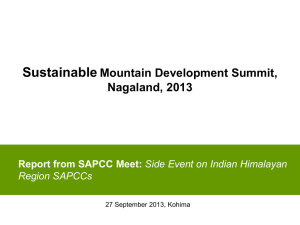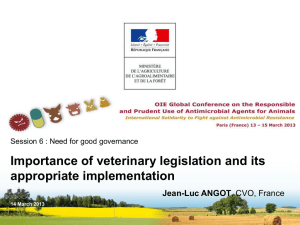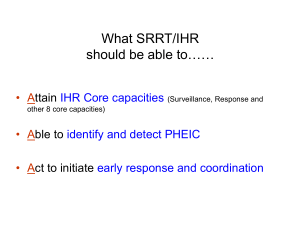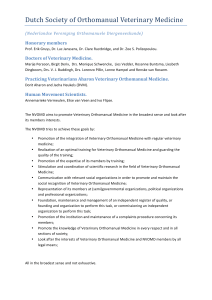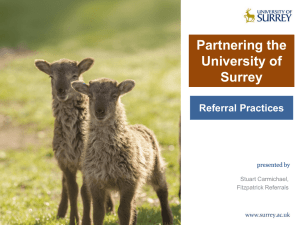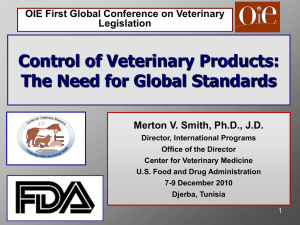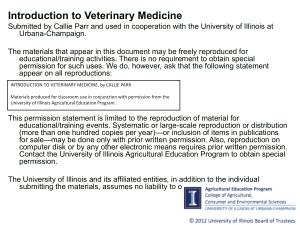Presentation of WHO - OIE
advertisement
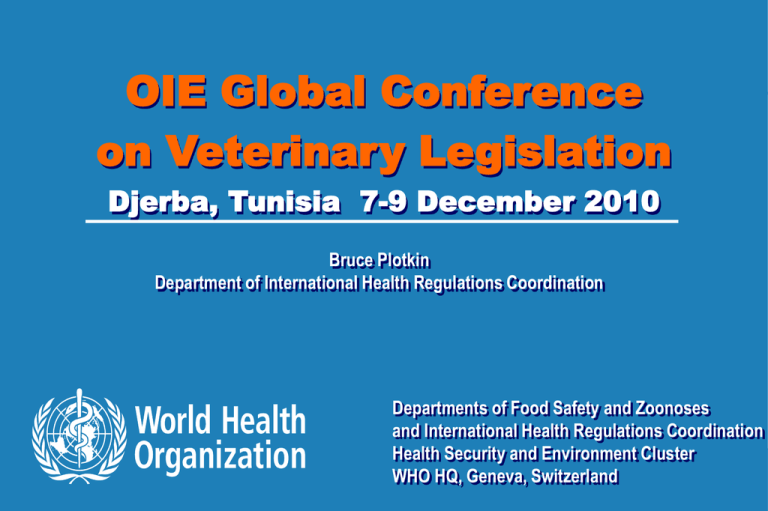
OIE Global Conference on Veterinary Legislation Djerba, Tunisia 7-9 December 2010 Bruce Plotkin Department of International Health Regulations Coordination Departments of Food Safety and Zoonoses and International Health Regulations Coordination Health Security and Environment Cluster | Presentation of WHO: OIE Global Conference on Veterinary Legislation WHO HQ, Geneva, Switzerland 1 | April 8, 2015 Outline of Presentation Codex Alimentarius: – What is it? What does it do? – Importance for national legislation International Health Regulations (2005): – Background, overview, scope – Key elements – Importance of intersectoral collaboration Legislative assessment and revision: – Lessons learned and practical suggestions 2| Presentation of WHO: OIE Global Conference on Veterinary Legislation | April 8, 2015 Codex Alimentarius Commission - what is it? Codex Alimentarius Commission (CAC) is an intergovernmental body operating within the United Nations Joint initiative of FAO and WHO (since 1963) – FAO/WHO Food Standards Programme 180 member governments, including the European Community as a member organization Approximately 20 technical committees Product is Codex Alimentarius (Latin for "food code") 3| Presentation of WHO: OIE Global Conference on Veterinary Legislation | April 8, 2015 Codex Alimentarius Commission - what does it do? Creates harmonized international food standards with a dual purpose: – “to protect the health of consumers” – “to ensure fair practices in the food trade” Also promotes coordination of all food standards work undertaken by international governmental and non-governmental organizations Standards, when introduced into national legislation, contribute to ensure safety of foods Commission meets annually - discuss and adopt international food standards, guidelines For examples, at its recent 33rd session, the commission considered: – guidelines on controlling bacteria in seafood throughout the food-chain; and – setting maximum residues level for ractopamine in meat 4| Presentation of WHO: OIE Global Conference on Veterinary Legislation | April 8, 2015 Codex standards Voluntary / Non-mandatory Reference for policy & decision-makers Since 1995, international standards references under the SPS and TBT Agreements of the World Trade Organization (WTO) International standards in SPS a. for food safety → Codex standards b. for animal health → OIE (World Organisation for Animal Health) c. for plant health → IPPC (Int'l Plant Protection Convention) 5| Presentation of WHO: OIE Global Conference on Veterinary Legislation | April 8, 2015 FAO/WHO Guidelines for strengthening national food control systems (2003) ANNEX 6 – Guidelines for Developing a National Food Law A set of guiding principles as a general approach to the drafting of food legislation Applicable to different legal systems Complement an in-depth analysis of the legal and institutional framework that govern food production, import, export, distribution, handling and sale in a particular country Prompt countries to take full advantage of Codex standards and food safety & quality lessons learned in other countries 6| Presentation of WHO: OIE Global Conference on Veterinary Legislation | April 8, 2015 International Health Regulations (2005) A (very) short history 1969 IHR covered 3 diseases: YF, cholera, plague Revision started 1995 –adopted by all States in 2005 IHR in force, and implemented, globally since 2007 Legally binding on 194 States Parties Concerns during revision included - EIDs, Zoonoses e.g. Ebola/VHFs, BSE, Nipah, SARS, avian influenza, future serious potentially unknown international risks Global legal framework against international spread of serious disease – Apply to government as a whole, not just particular ministry, department or agencies – Broad / open disease scope for early warning/response & to catch emerging risks – Overall framework: surveillance, response, support ,information sharing, capacities – Does not replace existing regulatory regimes – Does mandate collaboration 7| Presentation of WHO: OIE Global Conference on Veterinary Legislation | April 8, 2015 Major innovations From control at borders to containment at source and development of core public health capacities in all countries From disease list to broad range of serious int'l public health risks From preset health measures to generalized rules and risk assessment in particular context 8| Presentation of WHO: OIE Global Conference on Veterinary Legislation | April 8, 2015 Purpose and Scope of IHR "to prevent, protect against, control and respond to the international spread of disease… "in ways that are commensurate with and restricted to public health risks "and which avoid unnecessary interference with international traffic and trade" (Article 2) 9| Presentation of WHO: OIE Global Conference on Veterinary Legislation | April 8, 2015 Broad scope and coverage of IHR (2005) “Disease”: “an Illness or medical condition, irrespective of origin or source, that presents or could present significant harm to humans” “Event”: “a manifestation of disease or an occurrence that creates the potential for disease” "Public health risk": "the likelihood of an event that may adversely affect the health of human populations, …" Events/risks may be: – – – 10 | Biological/infectious, chemical, radionuclear Known or unknown, emerging or re-emerging Transmissible by persons, transport conveyances, cargo/goods food/animals/products), vectors, environment, etc. Presentation of WHO: OIE Global Conference on Veterinary Legislation | April 8, 2015 Government areas and functions affected by International Health Regulations Public health Agriculture (and animal health) Environment International ports, airports, ground crossings Radio-nuclear and chemical activities / safety Customs Food safety Borders / immigration 11 | Transportation (including dangerous goods) Collection, use and disclosure of public health information Activities of authorities at national, state/provincial/district, local levels. Presentation of WHO: OIE Global Conference on Veterinary Legislation | April 8, 2015 Animals / products References to animals in the IHR arise in mainly 2 contexts: "Goods" – part of provisions throughout the IHR Defined as: "tangible products, including animals and plants, transported on an international journey, including for utilization aboard a conveyance" "Animals" – additionally referenced separately (examples): Definitions: infection/disinfection, contamination/decontamination, reservoir/vector Port/airport authorities responsible for removal and safe disposal of animal dejecta and other contaminated items on conveyances Designated ports/airports must have capacities to assess and care for affected animals by arrangements with local veterinary facilities for isolation, treatment Ship Sanitation Inspections / certificates include animal reservoirs Maritime Declaration of Health includes disclosure of sick animals 12 | Presentation of WHO: OIE Global Conference on Veterinary Legislation | April 8, 2015 Key structures & mechanism National IHR Focal Point WHO IHR Contact Point In all countries available 24/7 for urgent communications with WHO IHR Contact Point on urgent events under the IHR (for e.g. notification/verification/follow-up) involving any covered risks Located in each of WHO’s 6 regional offices – for communications with the National IHR Focal Points Responsible for obtaining information from all government sectors on IHR-covered events (should include animal health), and for disseminating information to them. Works with WHO HQ, Country office and National government – on IHR events, technical support, capacity building Potential focus for intersectoral collaboration Has access to restricted IHR Event Information Site – information on selected (also OIE/FAO) 13 | Presentation of WHO: OIE Global Conference on Veterinary Legislation | April 8, 2015 Key IHR elements for veterinary health sector & legislation: Public Health Operations (potentially zoonoses, animals) WHO: Global surveillance, assessment, support / response States: Notification/reporting/verification of urgent health events to WHO States: Collaboration with National IHR Focal Points WHO: Information sharing with States on selected urgent events with potential international implications States: Regulation of application of health measures to int'l trade, transport and travelers and sanitary requirements at international ports/airports, crossings Keys for implementation by veterinary health sector: Awareness of IHR requirements, and Timely collaboration with IHR unit, including information sharing, through NFP or other mechanism 14 | Presentation of WHO: OIE Global Conference on Veterinary Legislation | April 8, 2015 Development of core public health capacities for surveillance and response All States Parties must develop/maintain national minimum public health capacities, including surveillance, assessment & response Required capacities: Detect, assess, control and report internally on public health events – according to specified criteria – At all levels and throughout national territory – Deadline for development: 2012/2014 Efforts to achieve these capacities ongoing worldwide – Development monitored with States and WHO support – Report on progress to the WHO World Health Assembly Includes your areas: Zoonoses and food-related risks – Critical area for intersectoral collaboration 15 | Presentation of WHO: OIE Global Conference on Veterinary Legislation | April 8, 2015 National IHR Core Public Health Capacities: Monitoring and reporting 8 Core capacities – – – – – – – – Legislation and Policy Coordination Surveillance Response Preparedness Risk Communications Human Resources Laboratory 3 levels – National – Intermediate – Peripheral/Community 16 | Potential Hazards – Biological • Infectious • Zoonosis • Food safety – Chemical – Radio nuclear Events at Points of Entry Presentation of WHO: OIE Global Conference on Veterinary Legislation | April 8, 2015 The requirements for intersectoral collaboration Required directly, and effectively indirectly under IHR (2005) Relevant mechanisms and provisions under the IHR (2005): – National IHR Focal Point in all countries: • Veterinary health sector a key authority with relevant public health information • May also be other IHR coordinating authority – National programme for meeting IHR Core capacity requirements – including zoonoses and food safety – These are subjects of national/WHO monitoring & reporting to World Health Assembly Coordination with National IHR authorities: – National veterinary legislation should be consistent with national organization for IHR implementation – Ongoing legislative assessment and revision process regarding IHR (2005) rights and obligations – presents an opportunity for synergies and efficiencies 17 | Presentation of WHO: OIE Global Conference on Veterinary Legislation | April 8, 2015 Assessment and revision of legislation Potential benefits: – Enable veterinary health sector to carry out its necessary specific tasks – Facilitate more efficient and effective functioning to achieve objectives – Enable or facilitate implementation of country’s rights and obligations under the range of relevant international laws – Empower the veterinary health sector – Institutionalize the role and activities of the sector within the government – Facilitate important inter-sectoral collaboration within government in activities relevant to veterinary health sector’s – Good governance Potential challenges include: institutional, technical, informational, resource 18 | Presentation of WHO: OIE Global Conference on Veterinary Legislation | April 8, 2015 Lessons learned in context of public health legislative assessment and revision Others in your government are probably also doing assessments / revision of legislation, some of which may relate to your intended legislation Legislation must be specific to domestic legal and governance systems, socio-political context Prioritize: – What may need to be done most urgently – What are most important elements for each State – Consider options to expedite the legislative process if urgently needed Process needs to involve all relevant sectors, offices, levels – May well save time / avoid obstacles later Process needs to involve not only options for high level legislation, but also regulations, rules, procedures that implement legislation operationally 19 | Presentation of WHO: OIE Global Conference on Veterinary Legislation | April 8, 2015 Practical suggestions – Preparations Contact relevant government legal advisors for appropriate procedures – if needed Consider developing awareness materials such as cabinet papers to facilitate support Start early to identify / mobilize governmental, technical, financial, other resources Contact other States (particularly those with similar national contexts) who are doing, or have done, similar assessments and revisions for their lessons learned, collaboration Contact your country's national authorities concerned with implementing the IHR (2005) rights and obligations and other relevant national/international obligations (e.g. WTO/Trade): 20 | Facilitates awareness of full legislative landscape relevant to veterinary legislation Can ensure consistency and effective implementation in areas of mutual concern Start early to identify existing legislation, regulations, rules relating to your proposed legislation - can take surprising time, and if are problems better to know early Presentation of WHO: OIE Global Conference on Veterinary Legislation | April 8, 2015 Resources: Guidance for full assessment Detailed, step by step guidance materials on WHO Website (IHR context) Most relevant: Brief Introduction: Considerations of Why, What, Who and How of legislative assessment and revision – as applied to IHR (2005) but much of it is generally applicable (and brief!) www.who.int/ihr/legal_issues/legislation/en/index.html 21 | Presentation of WHO: OIE Global Conference on Veterinary Legislation | April 8, 2015 www.who.int/ihr Thank you 22 | Presentation of WHO: OIE Global Conference on Veterinary Legislation | April 8, 2015

